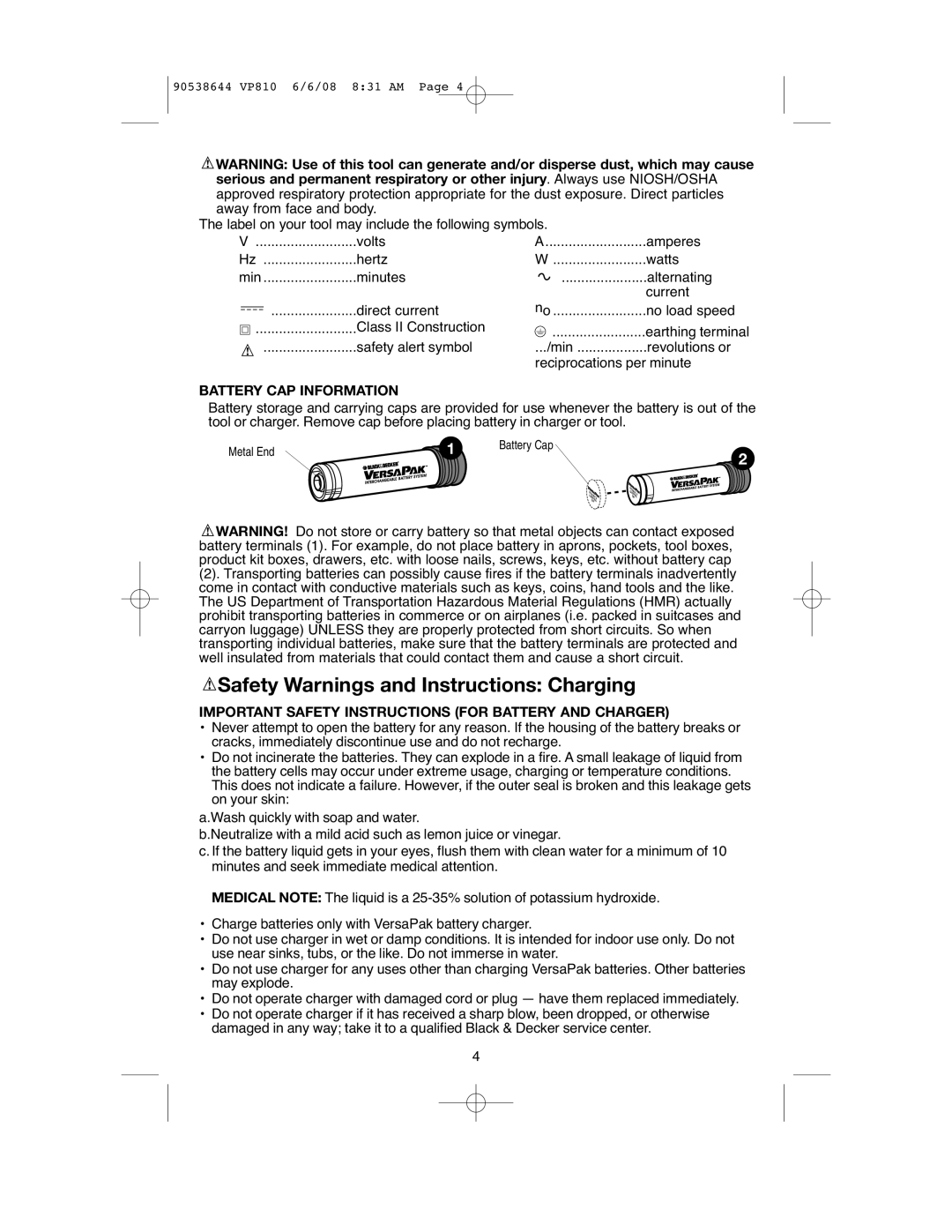
90538644 VP810 6/6/08 8:31 AM Page 4
![]() WARNING: Use of this tool can generate and/or disperse dust, which may cause serious and permanent respiratory or other injury. Always use NIOSH/OSHA approved respiratory protection appropriate for the dust exposure. Direct particles away from face and body.
WARNING: Use of this tool can generate and/or disperse dust, which may cause serious and permanent respiratory or other injury. Always use NIOSH/OSHA approved respiratory protection appropriate for the dust exposure. Direct particles away from face and body.
The label on your tool may include the following symbols. |
| |||||
V | volts | A | amperes | |||
Hz | hertz | W | watts | |||
min | minutes |
|
| ...................... | alternating | |
|
|
| no | current | ||
|
| direct current | no load speed | |||
|
| |||||
| .......................... | Class II Construction |
|
| ........................ | earthing terminal |
|
|
|
|
| ||
|
|
|
|
| ||
| ........................ | safety alert symbol | .../min | revolutions or | ||
|
|
| reciprocations per minute | |||
BATTERY CAP INFORMATION
Battery storage and carrying caps are provided for use whenever the battery is out of the tool or charger. Remove cap before placing battery in charger or tool.
Metal End | 1 | Battery Cap | 2 |
|
|
| |
|
| STORAGE& | CARRSTORAGE& |
|
| CAPYING | |
|
| CARRYINGCAP |
|
![]() WARNING! Do not store or carry battery so that metal objects can contact exposed battery terminals (1). For example, do not place battery in aprons, pockets, tool boxes, product kit boxes, drawers, etc. with loose nails, screws, keys, etc. without battery cap
WARNING! Do not store or carry battery so that metal objects can contact exposed battery terminals (1). For example, do not place battery in aprons, pockets, tool boxes, product kit boxes, drawers, etc. with loose nails, screws, keys, etc. without battery cap
(2). Transporting batteries can possibly cause fires if the battery terminals inadvertently come in contact with conductive materials such as keys, coins, hand tools and the like. The US Department of Transportation Hazardous Material Regulations (HMR) actually prohibit transporting batteries in commerce or on airplanes (i.e. packed in suitcases and carryon luggage) UNLESS they are properly protected from short circuits. So when transporting individual batteries, make sure that the battery terminals are protected and well insulated from materials that could contact them and cause a short circuit.
 Safety Warnings and Instructions: Charging
Safety Warnings and Instructions: Charging
IMPORTANT SAFETY INSTRUCTIONS (FOR BATTERY AND CHARGER)
•Never attempt to open the battery for any reason. If the housing of the battery breaks or cracks, immediately discontinue use and do not recharge.
•Do not incinerate the batteries. They can explode in a fire. A small leakage of liquid from the battery cells may occur under extreme usage, charging or temperature conditions. This does not indicate a failure. However, if the outer seal is broken and this leakage gets on your skin:
a.Wash quickly with soap and water.
b.Neutralize with a mild acid such as lemon juice or vinegar.
c.If the battery liquid gets in your eyes, flush them with clean water for a minimum of 10 minutes and seek immediate medical attention.
MEDICAL NOTE: The liquid is a
•Charge batteries only with VersaPak battery charger.
•Do not use charger in wet or damp conditions. It is intended for indoor use only. Do not use near sinks, tubs, or the like. Do not immerse in water.
•Do not use charger for any uses other than charging VersaPak batteries. Other batteries may explode.
•Do not operate charger with damaged cord or plug — have them replaced immediately.
•Do not operate charger if it has received a sharp blow, been dropped, or otherwise damaged in any way; take it to a qualified Black & Decker service center.
4
